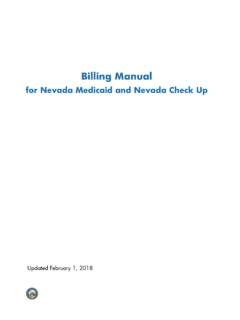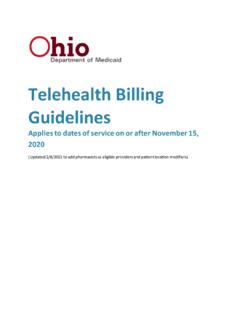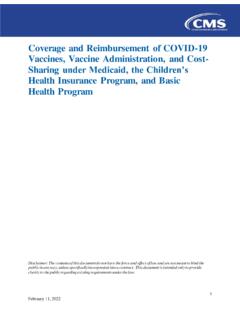Transcription of Pharmacy Auditing and Dispensing Job Aid: Billing Other ...
1 1 JOB AIDP harmacy Auditing and Dispensing Job Aid: Billing Other Dosage FormsPharmacists and their staff members have a responsibility to ensure patients receive the correct medication in the correct dosage form. The correct Billing of selected dosage forms can sometimes be difficult to decipher. A National Council for Prescription Drug Programs (NCPDP) pharmacist explains, Billing unit errors can have serious consequences when State medicaid agencies are involved, as underpayment or overpayment of rebates could generate a fraud investigation by the State or by the Centers for Medicare and medicaid Services (CMS). [1] The NCPDP Billing unit standard (BUS) helps pharmacists and staff members submit accurate claims for pharmaceutical products.
2 NCPDP created the BUS to provide guidance to Pharmacy claims software developers and to promote uniformity and consistency across standard Billing units.[2] The standards started by NCPDP address Billing unit inconsistencies within the health care delivery industry that may result in incorrect reimbursement or difficulties defining what constitutes a Billing unit. The standards provide a consistent and well-defined Billing unit for use in Pharmacy transactions, provide a method to assign a standard Billing unit, reduce the time it takes for a pharmacist to accurately bill a prescription and get paid correctly, and provides a standard Billing unit for use in calculation of accurate reimbursement and provides a standard size unit of measure for use in drug utilization review.
3 [3]The BUS employs only three Billing units to describe any and all drug products. These Billing units are milliliter, gram, and each.[4] Items billed as milliliter include any product measured by liquid volume, such as injectable products of 1 milliliter or greater, reconstitutable non-injectable products at the final volume after reconstitution, and some inhalers. Items billed as grams include those measured by weight such as creams or ointments in packages of 1 gram or greater, and some inhalers. Items billed as each include tablets, capsules, suppositories, transdermal patches, non-filled syringes, tapes, blister packs, oral powder packets, powder-filled vials for injection, unit-of-use packages with less than 1 milliliter or gram, and kits.
4 [5]In addition to selecting the correct Billing unit, calculation of the correct days supply can also be confusing. The dose of a drug is the quantitative amount of drug for administration or consumption that will produce the desired effect. If the calculated quantity does not appear on the prescription blank, the pharmacist or staff member must multiply the number of doses per day by the number of days treatment is required to calculate the quantity to be dispensed. To calculate the days supply, the pharmacist or staff member should divide the given or calculated quantity by the number of doses per day. However, days supply calculation is not always easy or intuitive when the pharmacist or staff member must consider kits, complex dosing regimens, and atypical dosing regimens.
5 Arriving at the correct days supply is as important as using the correct BUS when Billing medicaid . An incorrect days supply calculation can cause the beneficiary to receive the wrong amount of medication, can cause claim rejections, or may raise audit red flags.[6]Dosage CalculationsFollow these steps to calculate the correct days supply based on dosage ProductsTo calculate the days supply for inhalers, first calculate the total number of actuations or doses to be dispensed by multiplying the number of actuations or doses per inhaler by the number of inhalers to be dispensed. Then, divide the total number of actuations or doses to be dispensed by the number of actuations or doses required daily. Keep in mind, the BUS for inhalers will be the metric decimal quantity unit of measure labeled on the inhaler, which may be milliliter or grams.
6 When both milliliters and grams are supplied on the package label, use the first measurement unit listed. When Dispensing a unit dose product of less than 1 milliliter for administration via nebulizer, consider each unit dose each. Calculate the days supply by dividing the number of unit doses by the number of doses prescribed per day.[7] 2 Ophthalmic and Otic ProductsUsing a conversion factor of 20 drops per milliliter, calculate the days supply by dividing the total number of drops dispensed by the number of drops required for each day s dose. For example, consider an ophthalmic product to be dosed one drop in each eye twice daily and dispensed in a milliliter bottle. To calculate the total number of drops dispensed, multiply milliliters by 20 drops per milliliter to find 50 drops per bottle.
7 Divide 50 drops per bottle by 4 drops per day to find the correct days supply of ProductsTo calculate the days supply for vaginal products, consider the dosing interval between the insertion of the vaginal product and reinsertion of a new vaginal product. Take into consideration the number of days that must elapse before insertion of the new product. For example, if the beneficiary inserts a vaginal ring on day 1, removes it on day 21, observes a 7 day drug free interval, and reinserts on day 29, the correct days supply is 28. In addition, if the vaginal product has an extended dosing interval, such as every 90 days, the correct days supply is 90. If the labeled dosing and administration of the vaginal product differs for initiation dosing and maintenance dosing, calculate the days supply for initiation separately from maintenance.
8 For example, for beneficiaries initiating film-coated vaginal estradiol tables (Vagifem ), the correct days supply for the 18 tablet box is 28 days, based on the initiation dose of 1 tablet daily for 2 weeks, then twice weekly for 2 weeks. However, refills of this package size are not appropriate because the correct days supply for maintenance dosing for the 8 tablet box is 28 days based on twice weekly dosing.[8]Topical ProductsConsider the frequency and size of area to be treated. Generally, the smallest package size available should be sufficient to treat for Food and Drug Administration labeled indications. Also consider the Rule of Hand each gram will usually cover an area represented by four handprints.[9] For complex chronic conditions and those that involve frequent or large treatment areas, work with the prescriber to determine the maximum amount of topical product the beneficiary may need.
9 Document all calculations and prescriber clarification on the prescription blank. When Dispensing a unit dose product of less than 1 gram per unit dose, consider each unit dose each. Calculate the days supply by dividing the number of unit doses by the number of doses prescribed per day.[10]3 Other Dosage Forms Billing Unit Standard and Days Supply MatrixPlease review the following tables to help identify the correct Billing unit standard and the correct days supply for inhaled, ophthalmic, vaginal and topical dosage forms commonly associated with Billing 1. Inhaled ProductsBrand Name of DrugGeneric Name of DrugDosage FormBilling ErrorsNational Drug CodePackage SizeCommon Incorrect Billing QuantityCommon Incorrect Billing UnitsCommon Incorrect Days SupplyCorrectly Billed QuantityCorrectly Billed UnitsCorrectly Billed Days SupplyLabeled Indications & DoseCombivent[11]Albuterol/ipratropiumMe tered dose inhalerExcessive quantity when billed for number of doses instead of mcg/100 mcg per actuation x 120 doses120 Doses30 days4g30 daysChronic obstructive pulmonary disease.
10 1 inhalation 4 times a day, not to exceed 6 inhalations in 24 powder inhalerExcessive quantity when billed for number of doses instead of by the mcg per dose x 60 doses per canister60 Doses30 days1 Each (canister of less than 1 g)30 daysAsthma: adult starting dose is 360 mcg (two 180 mcg inhalations) twice daily. In some adult patients, a starting dose of 180 mcg (1 inhalation) twice daily may be adequate. The maximum dosage should not exceed 720 mcg (four 180 mcg inhalations) twice daily. Asthma pediatric patients six years of age or older: starting dose is 180 mcg (1 inhalation) twice daily. In some pediatric patients, a starting dose of 360 mcg (two 180 mcg inhalations) may be appropriate. The maximum dosage should not exceed 360 mcg (two 180 mcg inhalations) twice [12]BudesonideDry powder inhalerExcessive quantity when billed for number of doses instead of by the mcg per dose x 120 doses per canister120 Doses30 days1 Each (canister of less than 1 g)30 daysAsthma: adult starting dose is 360 mcg (two 180 mcg inhalations) twice daily.















